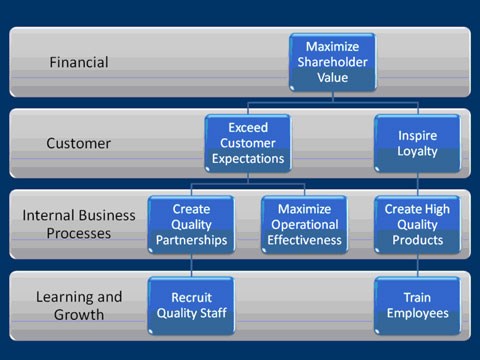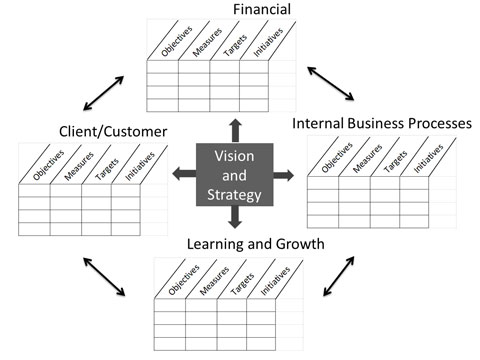How balanced is your company?
However, it was an accountant and his colleague who introduced us to keeping score in an entirely new way; and lo and behold in a way that could be easily understood.
Doctors in the house
Doctor (now Professor) Robert S Kaplan and his colleague Dr David P Norton discovered that financial measures alone are not sufficient to determine the success of the organisation's strategy. Financials such as return on equity employed are what are called 'lagging measures'; they are only indicative of past performance. We also need leading indicators that are markers for sustained performance.
In their book, The Balanced Scorecard, they begin their treatise with a conversation between a hypothetical passenger and a pilot
Q: I'm surprised to see you operating the plane with only a single instrument. What does it measure?
A: Airspeed. I'm really working on airspeed this flight.
Q: That's good. Airspeed certainly seems important. But what about altitude? Wouldn't an altimeter be helpful?
A: I worked on altitude for the last few flights and I've gotten pretty good on it. Now I have to concentrate on proper air speed.
Q: But I notice you don't even have a fuel gauge. Wouldn't that be useful?
A: You're right; fuel is significant, but I can't concentrate on doing too many things well at the same time. So on this flight I'm focusing on air speed. Once I get to be excellent at air speed, as well as altitude, I intend to concentrate on fuel consumption on the next set of flights.
It's about balance
This illustrates most aptly that we cannot just use financial performance (mostly a lagging indicator) to determine the potential trajectory of the company. The Balanced Scorecard is a bit of a misnomer, because it is really not a scorecard at all (although it resembles one), but a framework to translate the vision and strategy into operational terms. Although Vision is not dealt with in any great detail - and sometimes they use the term mission - also without clarification - they do provide a beautifully elegant definition of strategy:
Strategy is a set of hypotheses about cause and effect.
However they chicken out by also using those long-winded definitions that try to cover all bases resulting in something only its mother could love:
...we approach strategy as choosing the market and customer segments the business unit intends to serve, identifying the critical internal business processes that the unit must excel at to deliver the value proposition to customers in the targeted market segments, and selecting the individual and organizational capabilities required.
They cite - or I prefer 'blame - Michael Porter for the above - one of the hazards of always having to reference your work I guess.
The four perspectives
However, what is highly original about their work is that Kaplan and Norton propose four perspectives we need to articulate to create shared understanding of the vision and strategy of the organisation (although it is now somewhat common to see more than four measures in some scorecards) . The four perspectives are:
1. Financial
To succeed financially, how should we appear to our shareholders?
2. Customer
To achieve our vision, how should we appear to our customers?
3. Internal Business Process
To satisfy our shareholders and customers, what business processes must we excel at?
4. Learning and growth
To achieve our vision, how will we sustain our ability to change and improve?
The above four perspectives are somewhat of a reverse cascade. So going from perspective four to perspective one: we need to decide on what skills and capabilities we must have in our organisation to drive the internal processes to provide value to our customers to reach our financial goals. This is in effect a 'balanced' perspective on the organisation.
Maps for guidance
Kaplan and Norton also introduce us to Strategy Maps. Here we take the strategic goals and arrange them in a hierarchy subject to the four perspectives. Although they can get quite complex, this would be a simple generic example:

I like the fact that they call it a map, because a good strategy is just like a good map - it shows you all the information you need (leaving out the superfluous) to get from A to B.
Keeping score
The 'scorecard' element of the balanced scorecard is about monitoring and measuring each of the four categories. Essentially we have four columns:
1. Objectives
2. Measures
3. Targets
4. Initiatives
Below would be the visual representation of The Balanced Scorecard.

It's a pity they don't focus more on the concept of strategy, because that is the very starting point of the process - get that wrong and everything else is pretty much academic. However, there can be little doubt that when it comes to strategy, the most challenging aspect is implementation, and just like cricket, it's nice to have a scorecard designed specifically for the game.
To attend Sid Peimer's courses on strategy, visit the website www.stratplanning.com.
Sid Peimer provides freelance strategy, training and consulting. Details on the website www.stratplanning.com
About Sid Peimer
- Is consumer backlash affecting ad creativity? - 13 Feb 2023
- Cancel culture and the destruction of brands - 9 Mar 2022
- The most valuable capital of all: social capital - 24 Feb 2022
- Oh no, what have I done to outbound call centres? - 8 Feb 2019
- If Donald Trump wins, this is why - 25 Oct 2016
View my profile and articles...